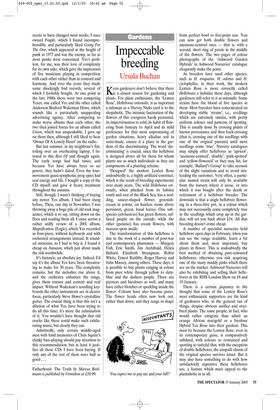Impeccable breeding
Ursula Buchan
VFen gardeners don’t believe that there leis a closed season for gardening and plants. For plant enthusiasts, the ‘Lenten Rose’, Helleborus orientalis, is as important a talisman as a Harvey Nicks card is to the shopaholic. The intrinsic fascination of the flowers of this evergreen hardy perennial, its imperviousness to cold, its habit of flowering from January to April and its mild preference for that most unpromising of garden situations, heavy alkaline soil in semi-shade, ensure it a place in the gardens of the discriminating. The word ‘discriminating’ is crucial, since the hellebore is designed above all for those for whom plants are as much individuals as they are components of a planting scheme.
‘Designed’ the modern Lenten Rose undoubtedly is, a highly artificial construct, which is the result of breeding experiments over many years. The wild Helleborus orientalis, when plucked from its habitat south and east of the Black Sea, has a nodding, saucer-shaped flower, greenishcream in colour, on hairless stems above persistent, green, basal leaves. One subspecies (abchasicus) has green flowers, suffused purple on the outside, while the other (guttatus) has cream flowers, with maroon spots inside.
The transformation of this hellebore is due to the work of a number of post-war and contemporary plantsmen — Margery Fish, Eric Smith, Jim Archibald, Helen Ballard, Elizabeth Strangman, Robin White, Ernest Raithby, Roger Harvey and John Massey, among others. These days, it is possible to buy plants ranging in colour from pure white through yellow to slatyblue and the darkest purple. There are picotees and bicolours as well, and many have either blotches or speckling inside the flower. Colours have also become purer. The flower heads often now look out, rather than down, and they range in shape from perfect bowl to five-point star. You can now get both double flowers and anemone-centred ones — that is, with a second, short ring of petals in the middle of the flowers. The two pages of colour photographs of the ‘Ashwood Garden Hybrids’ in Ashwood Nurseries’ catalogue eloquently make the point.
As breeders have used other species, such as H. torquatus, H. odorus and H. cyclophyllus, in their work, the modern Lenten Rose is more correctly called Helleborus x hybridus these days, although gardeners still refer to it as orientalis. Some strains have the blood of five species in them. Most breeders have concentrated on developing stable ‘strains’, i.e., seedlings which are extremely similar, with pretty uniform colours and patterns of spotting. This is usually done by crossing plants of known provenance and then back-crossing (that is, crossing one of the seedlings with one of the original parents) until most seedlings come ‘true’. Nursery catalogues may simply offer hellebores as ‘apricot’, ‘anemone-centred’, ‘double’, ‘pink-spotted’ and ‘yellow-flowered’ or they may list, for example, ‘Ballard’s Group’ to take account of the slight variations and to avoid misleading the customer. Very often, a particular named strain will only be available from the nursery where it arose, or into which it was bought after the death or retirement of a hellebore breeder. The downside is that a single hellebore flowering in a three-litre pot, in a colour which may not necessarily come completely true in the seedlings which crop up in the garden, will set you back about £14. All that breeding doesn’t come cheap.
A number of specialist nurseries hold hellebore open days in February, when you can see the range available, learn a bit about them and, most important, buy plants in flower. This is undoubtedly the best method of obtaining pure-coloured hellebores; otherwise you risk acquiring one of the many muddy pinks which there are on the market. Ashwood Nurseries will also be exhibiting and selling their hellebores at the RHS London Show on 18 and 19 January.
There is a certain piquancy in the thought that some of the Lenten Rose’s most enthusiastic supporters are the kind of gardeners who, in the general run of things, despise obvious artifice and overbred plants. The same people, in fact, who would rather emigrate than admit an orange African marigold or a bicolour Hybrid Tea Rose into their gardens. This must be because the Lenten Rose, even in its contemporary guise, is comparatively subdued, with colours so restrained and spotting so tasteful that, with the exception of double hellebores, the unspoilt charm of the original species survives intact. But it may also have something to do with how satisfactorily expensive these hellebores are, a feature which must appeal to the plantaholic in us all.





















































 Previous page
Previous page